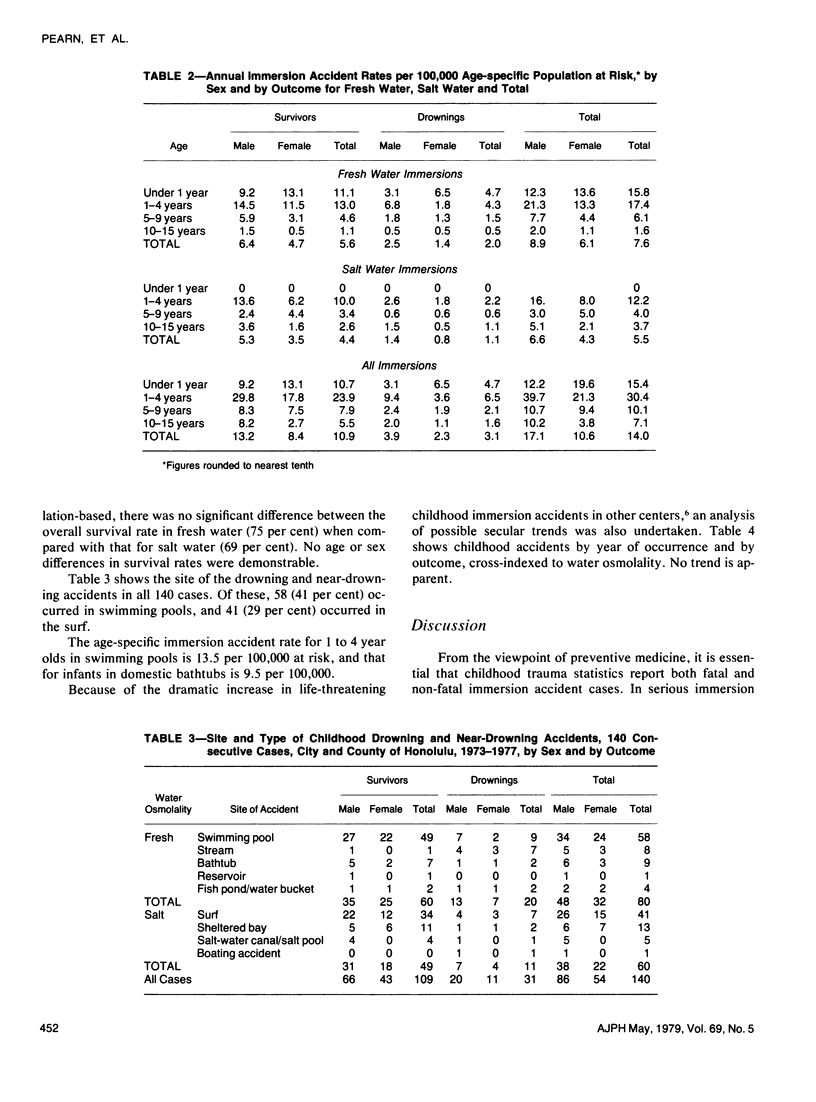Abstract
A study of all serious childhood immersion accidents (both drowned and near-drowned cases) is reported from Hawaii. This is a total population-based survey of 140 consecutive cases (0--15 years) occurring during the five-year period (1973--1977. Age-specific, sex-specific, and osmolality-specific (salt versus fresh water) data are presented both for survivors and fatalities. The overall annual drowning rate of 3.1 per 100,000 children at risk is low, for a water-oriented society. The survival rate following loss of consciousness in the water is 73 per cent. There is no evidence from this study that osmolality affected the probability of survival. The rank order of importance of drowning sites is swimming pools, surf, sheltered salt water bathing, domestic bath tubs, fresh water streams, salt water canals, and garden fish ponds. Specific accident rates, by sex, outcome, and site of immersion are also presented. No secular trend in the rate of drowning was observed in this study. Comparison with the only other available total population survey (Australia) of childhood immersions reveals common epidemiological and demographic patterns in modern urban societies and suggests that safety regulations play a role in reducing swimming accidents and fatalities in children.
Full text
PDF




Selected References
These references are in PubMed. This may not be the complete list of references from this article.
- Allen R. H., Eiseman B., Straehley C. J., Orloff B. G. Surfing injuries At waikiki. JAMA. 1977 Feb 14;237(7):668–670. [PubMed] [Google Scholar]
- Dietz P. E., Baker S. P. Drowning: epidemiology and prevention. Am J Public Health. 1974 Apr;64(4):303–312. doi: 10.2105/ajph.64.4.303. [DOI] [PMC free article] [PubMed] [Google Scholar]
- FULLER R. H. The clinical pathology of human near-drowning. Proc R Soc Med. 1963 Jan;56:33–38. [PMC free article] [PubMed] [Google Scholar]
- Fandel I., Bancalari E. Near-drowning in children: clinical aspects. Pediatrics. 1976 Oct;58(4):573–579. [PubMed] [Google Scholar]
- Kiefer N. C. Accidents--the foremost problem in preventive medicine. Prev Med. 1973 Mar;2(1):106–122. doi: 10.1016/0091-7435(73)90012-1. [DOI] [PubMed] [Google Scholar]
- Kristoffersen M. B., Rattenborg C. C., Holaday D. A. Asphyxial death: the roles of acute anoxia, hypercarbia and acidosis. Anesthesiology. 1967 May-Jun;28(3):488–497. [PubMed] [Google Scholar]
- Martin C. M., Barrett O., Jr Drowning and near-drowning: a review of ten years' experience in a large Army hospital. Mil Med. 1971 May;136(5):439–443. [PubMed] [Google Scholar]
- Modell J. H., Calderwood H. W., Ruiz B. C., Downs J. B., Chapman R., Jr Effects of ventilatory patterns on arterial oxygenation after near-drowning in sea water. Anesthesiology. 1974 Apr;40(4):376–384. doi: 10.1097/00000542-197404000-00013. [DOI] [PubMed] [Google Scholar]
- Nopanitaya W., Gambill T. G., Brinkhous K. M. Fresh water drowning. Pulmonary ultrastructure and systemic fibrinolysis. Arch Pathol. 1974 Dec;98(6):361–366. [PubMed] [Google Scholar]
- Pearn J. H., Nixon J. Swimming pool immersion accidents: an analysis from the Brisbane drowning study. Med J Aust. 1977 Mar 26;1(13):432–437. doi: 10.5694/j.1326-5377.1977.tb130794.x. [DOI] [PubMed] [Google Scholar]
- Pearn J. Drowning in Australia: a national appraisal with particular reference to children. Med J Aust. 1977 Dec 3;2(23):770–771. doi: 10.5694/j.1326-5377.1977.tb99279.x. [DOI] [PubMed] [Google Scholar]
- Pearn J. Neurological and phychometric studies in children surviving freshwater immersion accidents. Lancet. 1977 Jan 1;1(8001):7–9. doi: 10.1016/s0140-6736(77)91651-8. [DOI] [PubMed] [Google Scholar]
- Pearn J., Nixon J. Are swimming pools becoming more dangerous? Med J Aust. 1977 Nov 19;2(21):702–704. doi: 10.5694/j.1326-5377.1977.tb99227.x. [DOI] [PubMed] [Google Scholar]
- Pearn J., Nixon J. Prevention of childhood drowning accidents. Med J Aust. 1977 Apr 23;1(17):616–618. doi: 10.5694/j.1326-5377.1977.tb130960.x. [DOI] [PubMed] [Google Scholar]
- Pearn J., Nixon J., Wilkey I. Freshwater drowning and near-drowning accidents involving children: a five-year total population study. Med J Aust. 1976 Dec 18;2(25-26):942–946. doi: 10.5694/j.1326-5377.1976.tb115532.x. [DOI] [PubMed] [Google Scholar]
- Peterson B. Morbidity of childhood near-drowning. Pediatrics. 1977 Mar;59(3):364–370. [PubMed] [Google Scholar]
- Press E., Walker J., Crawford I. An interstate drowning study. Am J Public Health Nations Health. 1968 Dec;58(12):2275–2289. doi: 10.2105/ajph.58.12.2275. [DOI] [PMC free article] [PubMed] [Google Scholar]
- Ritchie B. C. The physiology of drowning. Med J Aust. 1972 Nov 18;2(21):1187–1189. doi: 10.5694/j.1326-5377.1972.tb103796.x. [DOI] [PubMed] [Google Scholar]
- Thompson J. Drowning and near-drowning in the Australian Capital Territory: a five-year total population study of immersion accidents. Med J Aust. 1977 Jan 29;1(5):130–133. [PubMed] [Google Scholar]


